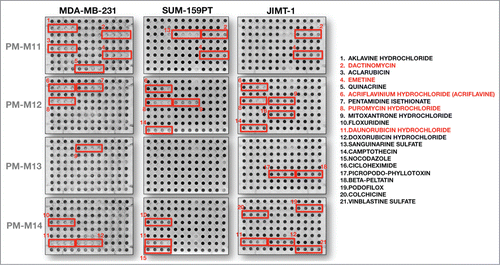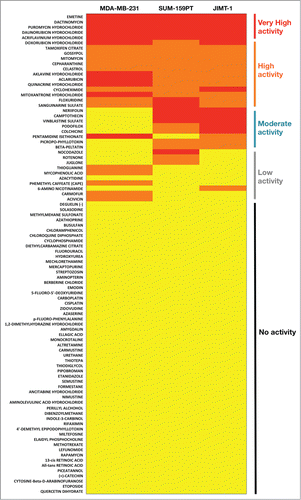Figures & data
Figure 1. Rapid screening for anti-breast cancer antibiotics using Biolog Phenotype Microarrays. Representative micrographs of Phenotype Microarray analyses measuring tetrazolium dye reduction by MDA-MB-231, SUM-159PT, and JIMT-1 breast carcinoma cells cultured in the absence or presence of 92 antibiotics and other growth inhibitors. Red boxes denote highly active drugs in which at least 3 of the 4 graded concentrations decreased optical density by ≥50 % in each individual cell line. Drug names labeled in red denote those drugs exhibiting high activity in all 3 breast cancer cell lines.

Figure 2. Chemosensitivity map of cell line models representative of breast cancer subtypes enriched for stem cell-like properties. A color-coding scheme assigned each drug to yellow (none of the 4 graded drug concentrations decreased cell growth by ≥50 %), orange (at least one of the 4 graded concentrations decreased cell growth by ≥50 %), or red (at least 3 of the 4 graded concentrations decreased cell growth by ≥50 %) categories. Drugs were categorized as “very high active” if the red code occurred in all 3 cell lines, “high activity” if either the red or orange codes occurred in all 3 cell lines, “moderate activity” if either the red or orange codes occurred in 2 of the 3 cell lines, “low activity” if either the red or orange codes occurred in one of the 3 cell lines, and “no activity” when none of the color-coding categories occurred in the 3 cell lines.

Figure 3. Inhibitors of ribosomal protein synthesis: (A)novel strategy to eradicate CSC traits in tumor tissues. Biologically aggressive, treatment-resistant breast cancer subtypes enriched for stem cell-like properties exhibit exacerbated chemosensitivities to antibiotics directly targeting active sites of the ribosome, such as emetine, puromycin and cycloheximide; inhibitors of ribosome biogenesis such as dactinomycin; ribotoxic stress agents such as daunorubicin, and indirect inhibitors of protein synthesis such as acriflavine. The repurposing of these old/existing microbicides and the development of second-generation inhibitors of ribosomal translation might constitute a valuable strategy to eradicate CSC traits in tumor tissues.

